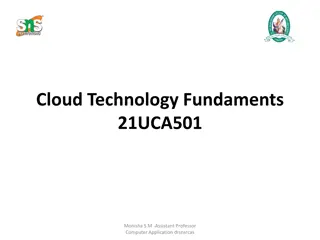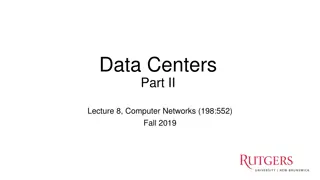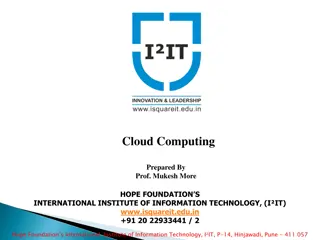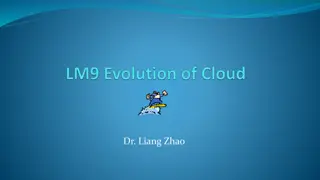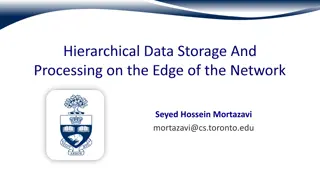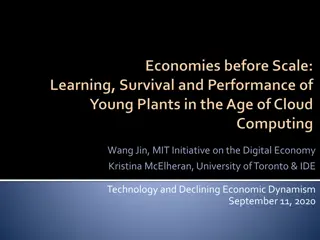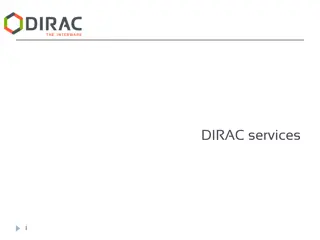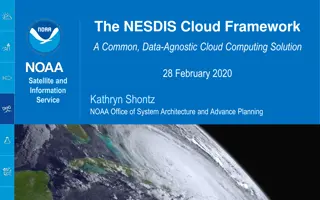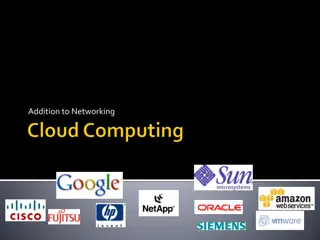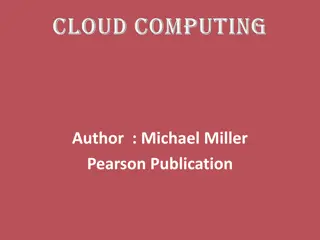An Overview of Big Data and Cloud Computing
Big data refers to vast and complex data sets difficult to process with traditional tools. Cloud computing tools like Hadoop and Spark enable the handling of big data. Types of big data include structured, unstructured, and semi-structured data. The evolution of technology, IoT devices, social media, and various industries contribute to the growth of big data. Big data platforms incorporate data collection, storage, and analysis processes.
Download Presentation

Please find below an Image/Link to download the presentation.
The content on the website is provided AS IS for your information and personal use only. It may not be sold, licensed, or shared on other websites without obtaining consent from the author.If you encounter any issues during the download, it is possible that the publisher has removed the file from their server.
You are allowed to download the files provided on this website for personal or commercial use, subject to the condition that they are used lawfully. All files are the property of their respective owners.
The content on the website is provided AS IS for your information and personal use only. It may not be sold, licensed, or shared on other websites without obtaining consent from the author.
E N D
Presentation Transcript
COM 1008 AN OVERVIEW OF CLOUD COMPUTING (NON-TECHNICAL) Hans Yip
Learning Objectives State-of-the-art cloud computing tools and applications: Cloud distributed system, e.g. Hadoop Cloud framework, e.g. MapReduce, Spark
What is Big Data? Big data is an all-encompassing term for any collection of data sets so large and complex that it becomes difficult to process using on-hand data management tools or traditional data processing applications. (From Wikipedia) Big Data refers to extremely vast amounts of multi-structured data that typically has been cost prohibitive to store and analyze. (My view) NOTE: However, big data is only referring to digital data, not the paper files stored in the basement at FBI headquarters, or piles of magnetic tapes in our data center.
Types of Big Data In the simplest terms, Big Data can be broken down into: Structured Predefined data type (Fixed Schema) Relational databases, transactional data such as sales records, Excel files such as customer information. This type of data normally can be stored into tables with columns and rows. Unstructured is non pre-defined data model or is not organized in a pre-defined manner. Data Lake is where the unstructured data will be stored. Video, Audio, Images, Metadata, books, satellite images, Adobe PDF files, notes in a web form, blogs, text messages, word documents Semi-structured Structured data embedded with some unstructured data Email, XML and JSON documents, and other markup languages NOTE: Semi-structured data falls in the middle between structured and unstructured data. It contains certain aspects that are structured, and others that are not.
Why Big Data? Evolution of Technology: New technologies generating large volume of data such as Mobile, Cloud, Smart car (self driving car). IoTs (Internet of Things): IoTs devices also generating huge data and sending them via Internet. (e.g. Wind Turbine, Gas Pump, Cargo Container, Energy Substation, Smartphone, Wearables, Animals, Shopping Cart, Vehicles, Smart Meter, Parking Meter, Sensors, Camera). We are expecting 50 Billion IoT devices by 2020. Social Media: Social media also generating quite large amount of data daily. (e.g. 204,000,000 emails, 1,736,111 Instagram pictures, facebook 4,166,667 likes and 200,000 photos, tweeter 347,222 tweets, Youtube 300 hours of video uploaded) Other factors: Transportation, Retail, Banking & Finance, Media & Entertainment, Healthcare, Education, Government also contributing large amount of data. Big Data captures, manages, processes the above fast growing data.
Big Data Platform Architecture Input Data (Collection of data from different data stores with different formats Structured, Unstructured, and Semi-structured) EDW Load Data Data Lake (repository that holds vast amount of raw data) Apache Hadoop Platform Data Mining Analytic tools Extract useful data Output Data (Files, Online reports)
Problems with Big Data Problem 1: Storing exponentially growing huge datasets. By 2020, total digital data will grow to 44 Zettabytes approximately. By 2020, about 1.7 MB of new information will be created every second for every person. Problem 2: Processing data having complex structure. Structured + un-structured + Semi-structured Problem 3: Processing data fast. The data is growing at much faster rate than that of disk read/write speed. Bringing huge amount of data to computation unit becomes a bottleneck.
The Solution Apache Hadoop Apache Hadoop is a framework that allows us to store and process large data sets in parallel and distributed fashion. (Open- source framework) Hadoop consists of two parts: HDFS (Hadoop Distributed File System) (Storage) allows to dump any kind of data across the cluster. MapReduce (Processing) allows parallel processing of the data stored in HDFS.
Apache Hadoop Components Hadoop HDFS (Storage): allows to dump any kind of data across the cluster MapReduce (Processing): allows parallel processing of the data stored in HDFS
HDFS Components HDFS (Hadoop Distributed File System): a distributed file system that provides high-throughput access to application data.
HDFS Components HDFS consists of: NameNode (Master): is the main node that maintains and manages DataNode contains metadata about the data stored. (Data block information such as location of blocks stored, the size of the files, permissions, hierarchy) Receives block report from all the DataNodes. DataNodes (slaves): are commodity hardware in the distributed environment. stores actual data serves read/write requests from the clients Secondary NameNode: is not a backup of NameNode, whose main function is to take checkpoints of the file system metadata present on NameNode. Checkpointing periodically applies edit log records to FsImage file and refresh the edit log. Stores a copy of FsImage file and edit log. If NameNode is failed, File System metadata can be recovered from the last saved FsImage. NOTE: FsImage is a snapshot of the HDFS file system metadata at a certain point of time. NOTE: Edit log is a transaction log which contains records for every change that occurs to file system metadata.
HDFS Components (Hadoop Cluster) NameNode (Master) Secondary NameNode DataNode DataNode DataNode DataNode (Slaves)
MapReduce Framework MapReduce: is a programming framework that allows us to perform distributed and parallel processing on large data sets in a distributed environment.
MapReduce Framework Map() Map() Map() Reduce() Reduce() Aggregated data Output Data Input Data Map Tasks Reduce Tasks HDFS
Big Data Problems Solved Problem 1: Storing exponentially growing huge datasets. Solution: Hadoop HDFS HDFS is a storage unit of Hardoop It is a Distributed File System (e.g. 512 MB file will be divided into 4 slaves with 128MB each. Divided files (input data) into smaller chunks and stores it across the cluster Scalable (easy to add DataNode)
Big Data Problems Solved Problem 2: storing unstructured data Solution: Hadoop HDFS Allows to store any kind of data, can be structured, semi- structured or unstructured. Follows WORM (Write Once Read Many) No schema validation is done while dumping data
Big Data Problems Solved Problem 3: Processing data faster Solution: Hadoop MapReduce Provides parallel processing of data present in HDFS Allows to process data locally. i.e. each node works with part of data which is stored on it.
WHAT IS HADOOP ECOSYSTEM?
HADOOP ECOSYSTEM
Big Data Opportunity Walmart story: Making a lot of money by selling Strawberry pop tarts during hurricane as a result of Big Data analysis. IBM smart meters: By collecting and analyzing data from smart meters, IBM discovered that during off-peak hours, users require less energy. Therefore, advises consumers to use heavy machines during off-peak hours to reduce cost and energy.
APACHE SPARK
What is Apache Spark? Apache Spark is a unified analytics engine for large-scale data processing (Big Data), with built-in modules for streaming, SQL, machine learning and graph processing. Apache Spark is a lightning-fast cluster computing technology, designed for fast computation. It is based on Hadoop MapReduce and it extends the MapReduce model to efficiently use it for more types of computations, which includes interactive queries and stream processing. The main feature of Spark is its in-memory cluster computing that increases the processing speed of an application. Spark is designed to cover a wide range of workloads such as batch applications, iterative algorithms, interactive queries and streaming. Apart from supporting all these workload in a respective system, it reduces the management burden of maintaining separate tools.
History of Apache Spark Spark is one of Hadoop s sub project developed in 2009 in UC Berkeley s AMPLab by Matei Zaharia. It was Open Sourced in 2010 under a BSD license. It was donated to Apache software foundation in 2013, and now Apache Spark has become a top level Apache project from Feb-2014.
Components of Spark Spark SQL for working with structured data Spark Streaming for real time analytic of streaming data MLib for machine learning GraphX for graph processing
Features of Apache Spark Speed: Run workloads 100x faster. Apache Spark achieves high performance for both batch and streaming data, using a state-of-the-art DAG scheduler, a query optimizer, and a physical execution engine. Ease of Use: Write applications quickly in Java, Scala, Python, R, and SQL. Spark offers over 80 high-level operators that make it easy to build parallel apps. And you can use it interactively from the Scala, Python, R, and SQL shells.
Features of Apache Spark Generality: Combine SQL, streaming, and complex analytics. Spark powers a stack of libraries including SQL and DataFrames,MLlib for machine learning,GraphX, and Spark Streaming. You can combine these libraries seamlessly in the same application. Runs Everywhere: Spark runs on Hadoop, Apache Mesos, Kubernetes, standalone, or in the cloud. It can access diverse data sources. You can run Spark using its standalone cluster mode, on EC2, on Hadoop YARN, on Mesos, or on Kubernetes. Access data in HDFS,Alluxio,Apache Cassandra,Apache HBase,Apache Hive, and hundreds of other data sources.
References https://www.edureka.co/blog/big-data-tutorial https://www.ijsr.net/archive/v5i6/NOV164121.pdf http://hadoop.apache.org/ https://www.youtube.com/watch?v=MfF750YVDxM (Hadoop) https://www.youtube.com/watch?v=AZovvBgRLIY (Hadoop) https://www.youtube.com/watch?v=9s-vSeWej1U (Hadoop) https://spark.apache.org/ https://www.tutorialspoint.com/apache_spark/index.htm (Spark tutorial) https://www.youtube.com/watch?v=QaoJNXW6SQo (Spark**)


